Learn what window grids are and how they’re used.
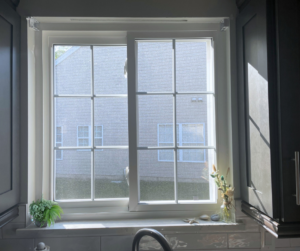 When getting quotes for new house windows you’ll be asked if you would like window grids. Knowing what they are, their purpose, and your options, will help you decide if window grids are the right choice for your replacement windows. Window grids can go by many names. The terms, often used interchangeably, include: Grids, Grilles, Mullions, and Muntins. For the sake of clarity, we’ll use grids in this article.
When getting quotes for new house windows you’ll be asked if you would like window grids. Knowing what they are, their purpose, and your options, will help you decide if window grids are the right choice for your replacement windows. Window grids can go by many names. The terms, often used interchangeably, include: Grids, Grilles, Mullions, and Muntins. For the sake of clarity, we’ll use grids in this article.
Brief History of Window Grids
Originally, window grids were used to hold smaller, individual panes of glass in place when window manufacturers built a window. This allowed window glass providers to ship their product in smaller pieces, drastically reducing the risk of the glass breaking in transit. Once the glass arrived at the window manufacturer, narrow strips of wood were used to sandwich the small glass panes together. The number and size of the panes used in the sash often depended on the finished size of the window.
When it comes to modern replacement window, grids are a strictly a decorative feature. The grids, assembled in the desired pattern during manufacturing, are inserted in-between the solid panes of glass to give the effect of smaller, individual panes, or lites. They are strictly a decorative feature and do affect the functionality or energy performance value of the window or patio door.
Grid Patterns
COLONIAL: Grids are most often seen in colonial style homes with hung windows. This traditional pattern is so popular, that it’s referred to as Colonial Grid pattern.
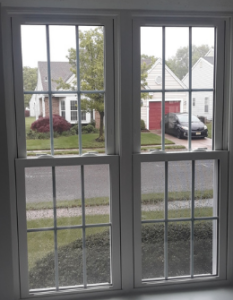 This set of Double Hung Window has the flat grid profile set in the colonial grid pattern. These window grid pattern gives the illusion of six, separate panes of glass in each sash.
This set of Double Hung Window has the flat grid profile set in the colonial grid pattern. These window grid pattern gives the illusion of six, separate panes of glass in each sash.
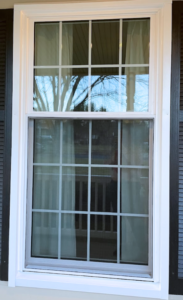 In the Oriel windows example on the right, you’ll see two different size sashes. Therefore, the numbers of panes will be different as well. This window has grids that form 8 panes on top, and 12 on the bottom.
In the Oriel windows example on the right, you’ll see two different size sashes. Therefore, the numbers of panes will be different as well. This window has grids that form 8 panes on top, and 12 on the bottom.
In both instances, the number of panes is reflected by the quantity of the top and bottom panes. #/#; or spoken as, “number over number.”
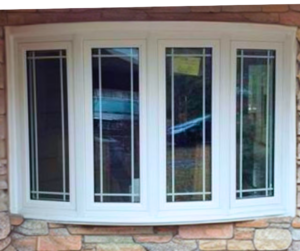
Five Lite Bay Window with Prairie Grids; White
PRARIE: The prairie pattern is often found in prairie or ranch style homes. This pattern typically uses flat grids in keeping with a more contemporary style. The grids are laid out near the perimeter of the windowpanes and divides the pane into several unequal sections. In this example, you’ll see varying sizes of rectangles, as well as smaller squares.
The result allows for more light to enter the space and provides a less obstructed view to the outdoors. Frank Lloyd Wright popularized this pattern, as it reinforces his organic architectural style.
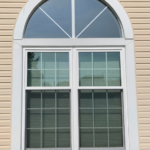
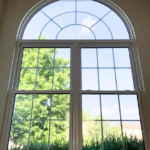 ARCHITECTURAL SHAPED WINDOWS: Architectural Shaped window grids have unique patterns as well. The popular Half-Circle (or Half-Round), window grids are often seen with Sunburst and Star grid patterns, but other, more complex patterns can be used as well.
ARCHITECTURAL SHAPED WINDOWS: Architectural Shaped window grids have unique patterns as well. The popular Half-Circle (or Half-Round), window grids are often seen with Sunburst and Star grid patterns, but other, more complex patterns can be used as well.
Grid Profiles
If you decide to get window grids, you’ll also be asked which grid profile you would like. The profile refers to the shape, or contour, of the grid piece itself. Jantek’s flat profile is rectangular in shape and is 5/8” high. Our contoured grid profile has a beveled, or raised, profile and is 11/16” high. The profile has no bearing on the performance of the unit, it is simply a decorative preference.
PATIO DOOR GRIDS
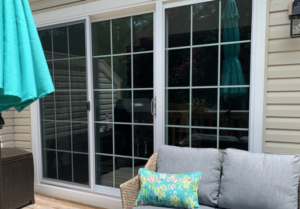
Three Panel Sliding Glass Patio Door with Grids; White
Grids are also used in Sliding Patio Doors. While patio door grids do not affect the energy value of the doors, they can be somewhat functional. While it may seem fairly obvious most times, we’ve all seen someone walk face first into a glass door. Grids can help signal to people that there is a piece of glass in front of them. This can be beneficial in homes with young children or with people who have compromised eyesight.
THE COST OF WINDOW GRIDS
The cost of the grids will depend on the window style, size, and color. Your Jantek representative can provide the cost of grids for each of your new windows on the provided quote.
Need a patio door quote? Our online TeleEstimate form allows you to get a hassle-free, same-day quote without a sales visit.



